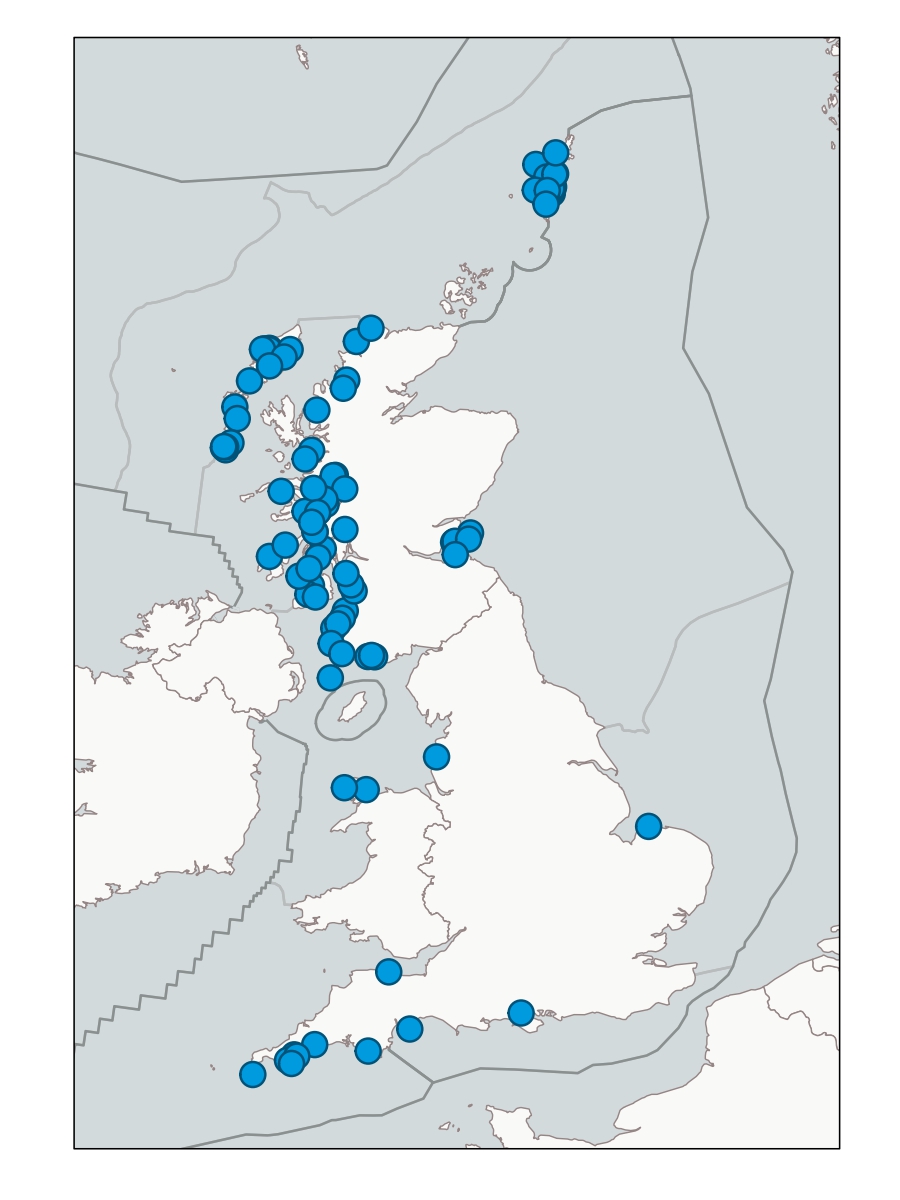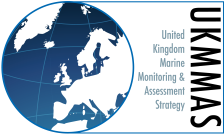Contaminants concentrations in seafood
Recent surveys (2016 – 2020) of contaminant concentrations in shellfish from fishing grounds, show that samples analysed for metals (cadmium, lead and mercury), Polycyclic Aromatic Hydrocarbons (PAHs), and dioxins and dioxin-like PCBs were compliant with regulations. This concludes that the UK target for descriptor 9 has been achieved for shellfish. No finfish have been sampled for contaminants in seafood for this reporting period, therefore no GES assessment under descriptor 9 for fish could be carried out.
Background
This indicator is used to assess progress against the target set out in the Marine Strategy Part One (HM Government, 2012), which requires that, for contaminants where regulatory levels have been set, there should be a high rate of compliance based on relevant surveys and including samples originating from commercial fishing grounds in the Greater North Sea and the Celtic Seas.
Key pressures and impacts
From the 2012 initial and 2018 UK assessment, the key pressures and impacts identified were the introduction of discharges, emissions and losses of persistent, toxic and bio-accumulating synthetic and non-synthetic chemicals such as pesticides, antifoulants, pharmaceuticals, heavy metals and hydrocarbons from various sources which impact the marine environment. These chemicals can reach the marine environment from various land-based and marine sources and can accumulate in marine sediments and rise through the food chain into seafood harvested for human consumption. These all remain relevant, and emerging contaminants of concern are kept under review, for example, through amendments to the EU and UK legislation.
Measures taken to address the impacts
The main measures to protect consumers from exposure to harmful levels of contaminants in fish and seafood are set out in the UK Marine Strategy Part Three (HM Government, 2015) and include Commission Regulation 1881/2006 as amended, which sets out limits for chemical contaminants in food. Under Regulation 178/2002, establishing the general principles of food law, action to protect public health can also be taken for unregulated contaminants on the basis of a risk assessment. Consumer protection is enhanced through precautionary advice to restrict the consumption of certain species at higher risk of contamination, such as oily fish (dioxins, polychlorinated biphenyls) and large predators (mercury).
Assessment method
Areas that have been assessed
The assessment scales used were the Greater North Sea and the Celtic Sea’s UK biogeographic regions. Table 1 provides an overview of the number of stations in each biogeographic region. In total, between 2016 and 2020, 99 stations were sampled (Table 1; Figure 1).
Monitoring and assessment methods
Samples of seafood known to have a risk of accumulating contaminants were collected through surveys of representative commercial fishing grounds in the Celtic Seas and the Greater North Sea. As only shellfish samples (blue mussel Mytilus edulis and Pacific oyster Crassostrea gigas) were analysed this time round, it should be noted the species might not include those at greatest risk of accumulation due to position in food web e.g., no commercial predatory fish species analysed. The data were either downloaded from the UK MERMAN database or derived from the Food Standards Agency (FSA) shellfish monitoring programme. The results were compared against human health assessment criteria (regulatory maximum levels) for heavy metals (cadmium, lead and mercury), Polycyclic aromatic hydrocarbons, dioxins and dioxin-like PCBs.
Table 1. Numbers of stations sampled in seven biogeographic regions
|
Biogeographic Region |
Station Numbers |
|
Northern North Sea |
11 |
|
Southern North Sea |
1 |
|
Eastern Channel |
2 |
|
Western Channel and Celtic Sea |
8 |
|
Irish Sea |
22 |
|
Minches and Western Scotland |
36 |
|
Scottish Continental Shelf |
19 |

Figure 1. Sampling stations for Descriptor 9
Results
All analysed shellfish samples for metals, PAHs and dioxins and dioxin-like PCBs were compliant with current regulations. A breakdown can be seen in Table 2. This table also include the relevant assessment criteria set in Retained European Law Regulation (EC) No 1881/2006. As can be seen from Table 1, there is a disparity in of the number of samples collected and analysed from northern waters compared to those further south and east.
Heavy metals
Of the 97 samples tested for lead, 125 samples tested for cadmium and 59 samples tested for mercury, there were no non-compliant samples.
Polycyclic aromatic hydrocarbons (PAHs)
Of the 14 total samples tested, there were no non-compliant samples for either benzo(a)pyrene or the sum of four PAHs (benzo(a)anthracene, chrysene, benzo(b)fluoranthene and benzo(a)pyrene).
Dioxins
One sample was analysed for dioxins and dioxin-like PCBs and was compliant.
All results show that, for the shellfish samples tested, there was a high level of compliance with regulatory thresholds set in legislation.
Table 2. Summary results of the shellfish sampled between 2016 and 2020 for compliance with the relevant human health standards.
|
Contaminant |
n |
Mean |
95th Percentile |
Maximum |
Limit |
Units |
|
Metals |
|
|
|
|
|
|
|
Lead |
97 |
0.13 |
0.39 |
1.18 |
1.5 |
mg/kg |
|
Cadmium |
125 |
0.1 |
0.22 |
0.74 |
1 |
mg/kg |
|
Mercury |
59 |
0.01 |
0.03 |
0.04 |
0.5 |
mg/kg |
|
PAHs |
|
|
|
|
|
|
|
Benzo(a)anthracene |
14 |
1.28 |
- |
3.98 |
* |
μg/kg |
|
Chrysene |
14 |
1.36 |
- |
4.04 |
* |
μg/kg |
|
Benzo(b)fluoranthene |
14 |
2.59 |
- |
8.04 |
* |
μg/kg |
|
Benzo(a)pyrene |
14 |
0.99 |
- |
3.44 |
5 |
μg/kg |
|
Sum of PAH4 (no individually set maximum levels) |
14 |
6.2 |
- |
19.5 |
30 |
μg/kg |
|
Dioxins and dioxin-like PCBs |
|
|
|
|
|
|
|
Sum of dioxins |
1 |
0.5 |
- |
- |
3.5 |
pg/g |
|
Sum of dioxins and dioxin-like PCBs |
1 |
0.81 |
- |
- |
6.5 |
pg/g |
|
Sum of ICES 6 |
1 |
3.64 |
- |
- |
75 |
ng/g |
Conclusions
The recent investigations show that there has been a 100% compliance with regulatory levels for shellfish and confirm the findings of the Updated Assessment in 2018 that the target for this descriptor already achieved in both the Celtic Seas and the Greater North Sea. No fish samples were analysed this time around as no fish data available since the last UKMS Part 1 assessment. Therefore, GES conclusion is based on shellfish alone.
Knowledge gaps
Currently only a small number of shellfish samples were used for this assessment. Going forward, fish should also be assessed against human health regulatory assessment criteria to establish if fish are also reaching this level of compliance. In the updated Assessment in 2018 a few samples were above set assessment criteria in fish. The sampling distribution around the UK was also very variable and more needs to be done to ensure that more samples are being collected and analysed from the Southern North Sea, the Eastern Channel, and Western Channel and Celtic Sea. The majority of shellfish samples used for this assessment came from Scottish or Northern Irish waters.
References
HM Government. (2012) ‘Marine Strategy Part One: UK Initial Assessment and Good Environmental Status’ (accessed 17th October 2023) at https://www.gov.uk/government/publications/marine-strategy-part-one-uk-initial-assessment-and-good-environmental-status.
HM Government (2015) ‘Marine Strategy Part Three: UK Programme of Measures’ (accessed 17th October 2023) at https://www.gov.uk/government/publications/marine-strategy-part-three-uk-programme-of-measures
Retained Regulation (EC) No 1881/2006 of 19 December 2006 setting maximum levels for certain contaminants in foodstuffs (Text with EEA relevance), available at: https://www.legislation.gov.uk/eur/2006/1881 (accessed 17th October 2023)
Retained Regulation (EC) No 178/2002 of the European Parliament and of the Council of 28 January 2002 laying down the general principles and requirements of food law, establishing the European Food Safety Authority and laying down procedures in matters of food safety, available at: https://www.legislation.gov.uk/eur/2002/178/ (accessed 17th October 2023)
Retained Regulation (EU) 2017/644 of 5 April 2017 laying down methods of sampling and analysis for the control of levels of dioxins, dioxin-like PCBs and non-dioxin-like PCBs in certain foodstuffs and repealing Regulation (EU) No 589/2014 (Text with EEA relevance), available at: https://www.legislation.gov.uk/eur/2017/644/ (accessed 17th October 2023)
Retained Regulation (EU) 2016/582 of 15 April 2016 amending Regulation (EC) No 333/2007 as regards the analysis of inorganic arsenic, lead and polycyclic aromatic hydrocarbons and certain performance criteria for analysis (Text with EEA relevance), available at: https://www.legislation.gov.uk/eur/2016/582 (accessed 17th October 2023)
Authors
E. E. Manuel Nicolaus1 and Izaak Fryer-Kanssen2
1Centre for Environment, Fisheries and Aquaculture
2Food Standards Agency
Assessment metadata
| Assessment Type | UK MSFD Indicator Assessment |
|---|---|
D9 Contaminants in seafood | |
| Point of contact email | marinestrategy@defra.gov.uk |
| Metadata date | Sunday, June 1, 2025 |
| Title | Contaminants in fish and seafood |
| Resource abstract | |
| Linkage | |
| Conditions applying to access and use | © Crown copyright, licenced under the Open Government Licence (OGL). |
| Assessment Lineage | |
| Dataset metadata | |
| Links to datasets identifiers | Please, see reference above |
| Dataset DOI | Scottish Government, Food Standards Agency (FSA), British Oceanographic Data Centre, Food Standards Scotland (FSS). 2025. 2025 Marine Strategy Assessment - Descriptor 9 - contaminants in seafood. doi: 10.7489/12545-1 https://doi.org/10.7489/12545-1 |
The Metadata are “data about the content, quality, condition, and other characteristics of data” (FGDC Content Standard for Digital Geospatial Metadata Workbook, Ver 2.0, May 1, 2000).
Metadata definitions
Assessment Lineage - description of data sets and method used to obtain the results of the assessment
Dataset – The datasets included in the assessment should be accessible, and reflect the exact copies or versions of the data used in the assessment. This means that if extracts from existing data were modified, filtered, or otherwise altered, then the modified data should be separately accessible, and described by metadata (acknowledging the originators of the raw data).
Dataset metadata – information on the data sources and characteristics of data sets used in the assessment (MEDIN and INSPIRE compliance).
Digital Object Identifier (DOI) – a persistent identifier to provide a link to a dataset (or other resource) on digital networks. Please note that persistent identifiers can be created/minted, even if a dataset is not directly available online.
Indicator assessment metadata – data and information about the content, quality, condition, and other characteristics of an indicator assessment.
MEDIN discovery metadata - a list of standardized information that accompanies a marine dataset and allows other people to find out what the dataset contains, where it was collected and how they can get hold of it.
